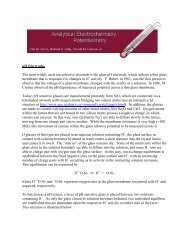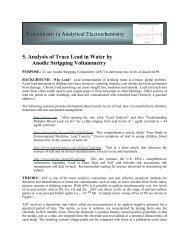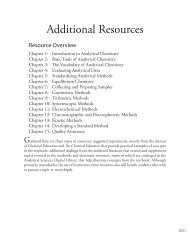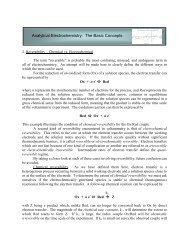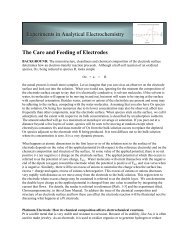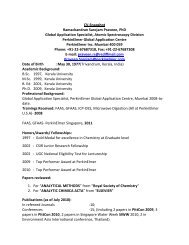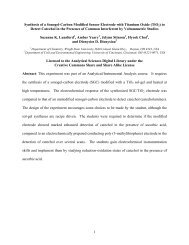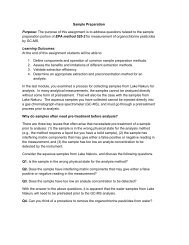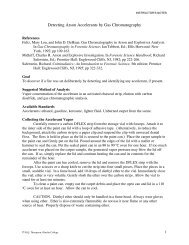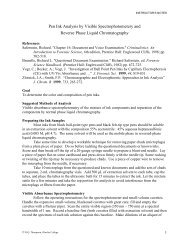Chapter 5 - Analytical Sciences Digital Library
Chapter 5 - Analytical Sciences Digital Library
Chapter 5 - Analytical Sciences Digital Library
You also want an ePaper? Increase the reach of your titles
YUMPU automatically turns print PDFs into web optimized ePapers that Google loves.
182 <strong>Analytical</strong> Chemistry 2.0<br />
Practice Exercise 5.5<br />
Using your results from Practice Exercise 5.4, construct a residual plot<br />
and explain its significance.<br />
Click here to review your answer to this exercise.<br />
errors are not random, suggesting that the data can not be modeled with a<br />
straight-line relationship. Regression methods for these two cases are discussed<br />
in the following sections.<br />
5D.3 Weighted Linear Regression with Errors in y<br />
Our treatment of linear regression to this point assumes that indeterminate<br />
errors affecting y are independent of the value of x. If this assumption is<br />
false, as is the case for the data in Figure 5.13b, then we must include the<br />
variance for each value of y into our determination of the y-intercept, b o ,<br />
and the slope, b 1 ; thus<br />
b<br />
1<br />
b<br />
0<br />
=<br />
∑<br />
i<br />
wy−b w x<br />
i<br />
i<br />
n<br />
1<br />
∑<br />
∑ ∑ ∑<br />
i<br />
i<br />
i<br />
5.26<br />
n w xy−<br />
wx wy<br />
i i i<br />
i i i i<br />
i<br />
i i<br />
=<br />
2<br />
5.27<br />
2<br />
n w x − w x<br />
∑<br />
i<br />
i<br />
i<br />
∑<br />
i<br />
i<br />
i<br />
This is the same data used in Example 5.9<br />
with additional information about the<br />
standard deviations in the signal.<br />
where w i is a weighting factor that accounts for the variance in y i<br />
ns ( )<br />
−2<br />
yi<br />
w =<br />
i<br />
−2 5.28<br />
s<br />
∑<br />
i<br />
( )<br />
and s yi<br />
is the standard deviation for y i . In a weighted linear regression,<br />
each xy-pair’s contribution to the regression line is inversely proportional<br />
to the precision of y i —that is, the more precise the value of y, the greater<br />
its contribution to the regression.<br />
Example 5.12<br />
Shown here are data for an external standardization in which s std is the<br />
standard deviation for three replicate determination of the signal.<br />
C std (arbitrary units) S std (arbitrary units) s std<br />
0.000 0.00 0.02<br />
0.100 12.36 0.02<br />
0.200 24.83 0.07<br />
yi



